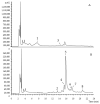Biological Activity of Pumpkin Byproducts: Antimicrobial and Antioxidant Properties
- PMID: 36500462
- PMCID: PMC9739767
- DOI: 10.3390/molecules27238366
Biological Activity of Pumpkin Byproducts: Antimicrobial and Antioxidant Properties
Abstract
Pumpkin fruits are widely appreciated and consumed worldwide. In addition to their balanced nutritional profile, pumpkin species also present valuable bioactive compounds that confer biological and pharmacological properties to them. However, the seeds, peels, and fibrous strands resulting from pumpkin processing are still poorly explored by the food industry. The current study used those fruit components from the genotypes of pumpkin that are economically significant in Portugal and Algeria to produce bioactive extracts. In order to support their usage as preservatives, their phenolic content (HPLC-DAD-ESI/MS) and antioxidant (OxHLIA and TBARS) and antimicrobial properties (against eight bacterial and two fungal strains) were assessed. In terms of phenolic profile, the peel of the Portuguese 'Common Pumpkin' showed the most diversified profile and also the highest concentration of total phenolic compounds, with considerable concentrations of (-)-epicatechin. Regarding the antioxidant capacity, the seeds of 'Butternut Squash' from both countries stood out, while the fibrous strands of Portuguese 'Butternut Squash' and the seeds of Algerian 'Gold Nugget Pumpkin' revealed the strongest antimicrobial activity. The bioactive compounds identified in the pumpkin byproducts may validate their enormous potential as a source of bio-based preservatives that may enhance consumers' health and promote a circular economy.
Keywords: antimicrobial activity; antioxidant activity; bio-based food preservatives; biologically active compounds; phenolic profile; pumpkin byproducts.
Conflict of interest statement
The authors declare that they have no conflict of interest.
Figures
References
-
- Rocchetti G., Pagnossa J.P., Blasi F., Cossignani L., Hilsdorf Piccoli R., Zengin G., Montesano D., Cocconcelli P.S., Lucini L. Phenolic profiling and in vitro bioactivity of Moringa oleifera leaves as affected by different extraction solvents. Food Res. Int. 2020;127:108712. doi: 10.1016/j.foodres.2019.108712. - DOI - PubMed
-
- Ceccanti C., Finimundy T.C., Melgar B., Pereira C., Ferreira I.C.F.R., Barros L. Sequential steps of the incorporation of bioactive plant extracts from wild Italian Plantago coronopus L. and Cichorium intybus L. leaves in fresh egg pasta. Food Chem. 2022;384:132462. doi: 10.1016/j.foodchem.2022.132462. - DOI - PubMed
-
- Takwa S., Caleja C., Barreira J.C.M., Soković M., Achour L., Barros L., Ferreira I.C.F.R. Arbutus unedo L. and Ocimum basilicum L. as sources of natural preservatives for food industry: A case study using loaf bread. LWT. 2018;88:47–55. doi: 10.1016/j.lwt.2017.09.041. - DOI
-
- Jesus M.S., Genisheva Z., Romaní A., Pereira R.N., Teixeira J.A., Domingues L. Bioactive compounds recovery optimization from vine pruning residues using conventional heating and microwave-assisted extraction methods. Ind. Crops Prod. 2019;132:99–110. doi: 10.1016/j.indcrop.2019.01.070. - DOI
-
- Besrour N., Oludemi T., Mandim F., Pereira C., Dias M.I., Soković M., Stojković D., Ferreira O., Ferreira I.C.F.R., Barros L. Valorization of Juglans regia Leaves as Cosmeceutical Ingredients: Bioactivity Evaluation and Final Formulation Development. Antioxidants. 2022;11:677. doi: 10.3390/antiox11040677. - DOI - PMC - PubMed
MeSH terms
Substances
LinkOut - more resources
Full Text Sources
Molecular Biology Databases



